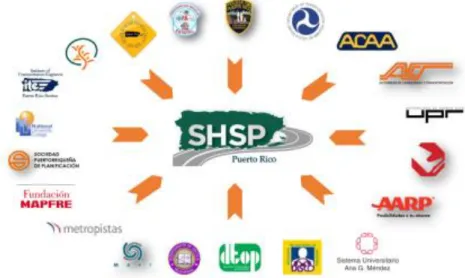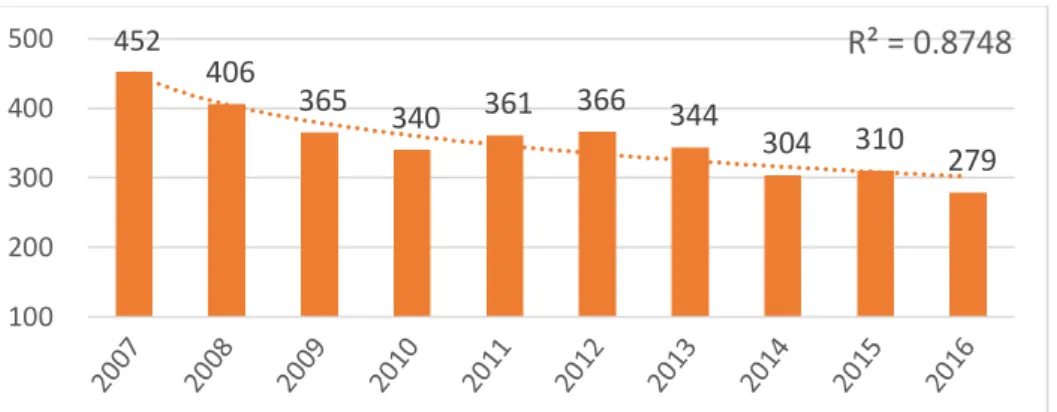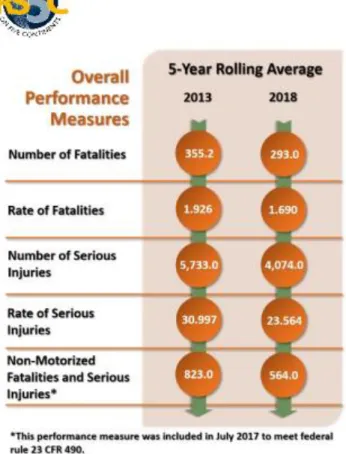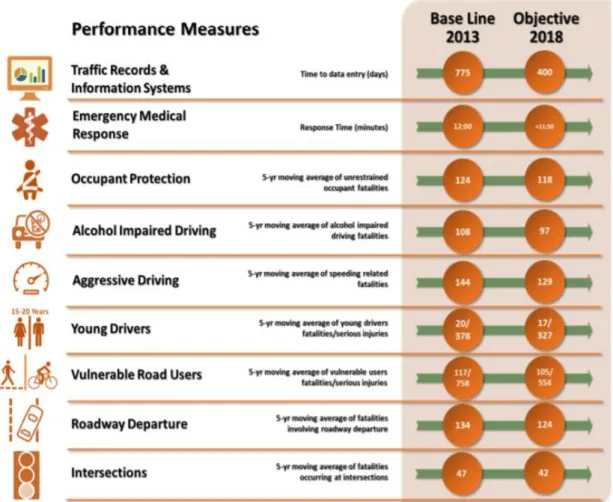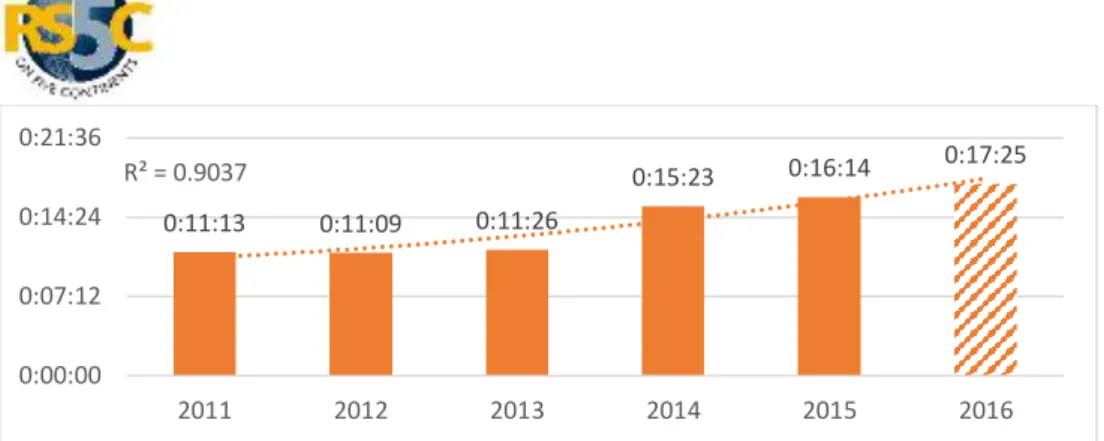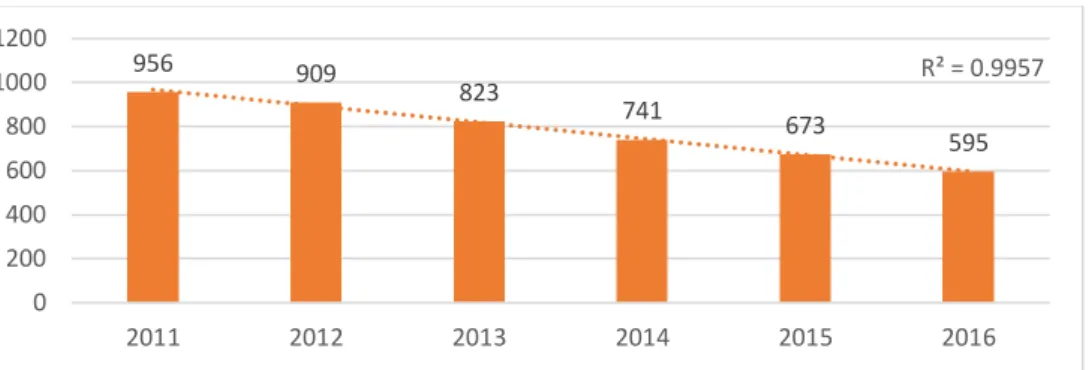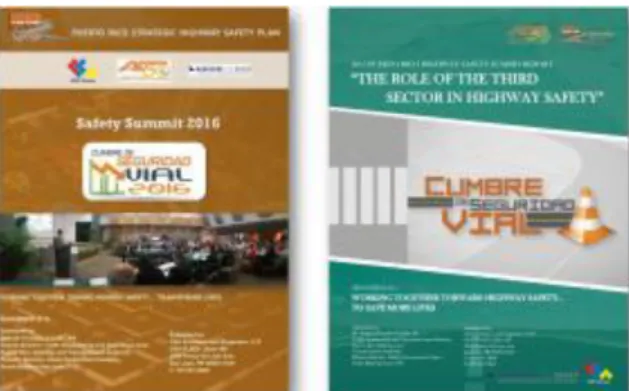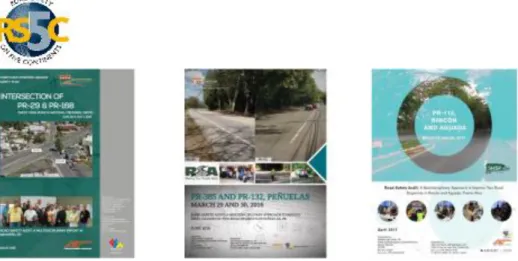1 (13)
ACCOMPLISHMENTS AND LESSONS LEARNED OF THE FIRST
FOUR YEARS OF THE IMPLEMENTATION OF THE PUERTO RICO
STRATEGIC HIGHWAY SAFETY PLAN
Benjamín Colucci PhD, P.E., FITE, PTOE, PAE, JD Professor, University of Puerto Rico at Mayagüez
Civil Engineering and Surveying Department, Mayagüez, Puerto Rico, 00680 Phone: 787-832-4040 ext. 3393 E-mail: benjamin.colucci1@upr.edu
Co-authors(s): Juan Carlos Rivera, MECE, P.E., PRHTA; Lynnette Alicea León, MSCE, EIT, CSA Architects and Engineers, LLP.
ABSTRACT
The Department of Transportation and Public Works (DTPW) of the Government of Puerto Rico established the Strategic Highway Safety Plan (PR-SHSP) 2014-2018. The goal of this five-year plan is to achieve a reduction in the number of fatalities and serious injuries on Puerto Rico public roadways with the slogan working together toward highway safety to save more lives.
This paper provides an overview of the Strategic Highway Safety Plan in Puerto Rico, its principal components and the lessons learned throughout its implementation process. The rationale associated with the identification and selection process of the primary/core Emphasis Areas, namely traffic records and information systems, emergency medical response, and occupant protection. The other six Emphasis Areas are alcohol impaired driving, aggressive driving, vulnerable road users, young drivers (15-20 years old), roadway departure, and intersections are described.
Short to medium-range guidelines on how to implement SHSP at the international level, including road user educational campaigns and related success stories from the safety stakeholders are described.
2 (13)
1. INTRODUCTION
The Federal Highway Administration (FHWA) of the United States Department of Transportation (USDOT) approved the Puerto Rico Strategic Highway Safety Plan (PR-SHSP) 2014-2018 in July 30, 2014 [1]. This plan was a result of several years of hard work of transportation officials from the Puerto Rico Highway and Transportation Authority (PRHTA) and safety stakeholders representing the public and private sectors, non-government organizations (NGOs), and the academia (see Figure 1).
Figure 1: PR-SHSP Safety Stakeholders (Source: carreterasegurapr.com)
The PR-SHSP has been successful in its implementation based on the following affirmative actions: (1) Meeting the federal regulations and been aware of the corresponding upgrades related to the Highway Safety Improvement Program (HSIP) and other safety- related regulations; (2) Focusing on local needs and methods; (3) Relying on safety stakeholders from all sectors and from the 4Es; (4) Implementing different communications strategies to spread the message(s) among safety stakeholders and the public, and (5) Performing objective safety evaluations based on the best and pertinent data available.
Prior to the implementation of the PR-SHSP, the best and pertinent data available included traffic indicators and crash trends, including fatalities data. Table 1 presents a representative sample of these traffic indicators during the 2008-2013 period. Based on this table, the following observations can be described:
• Initial reduction in traffic fatalities and fatal crashes during the six-year period • Reduction in vehicle-miles traveled (VMT)
• A slight increase in roadway miles
• Increase in the total crashes reported from 2011 to 2013
The PR-SHSP defined nine Emphasis Areas based on the fatality and crash data analyzed. The fatality data documented in the Fatal Analysis Reporting System (FARS) is, available through the Puerto Rico Traffic Safety Commission (PRTSC). The crash data, accessed using the Critical Analysis Reporting Environment (CARE) software, is available through the PR-DTPW.
According to the Emphasis Area report (PR-SHSP 2014) the six main contributing factors for the fatal and injury crashes on the Commonwealth’s highway network are aggressive driving (43%), vulnerable users (32%), alcohol impaired drivers (28%), roadway departure (25.5%), young drivers between 15 and 20 years of age (25.4%), and intersections (13%).
The data obtained from FARS, CARE and the historic traffic indicators, along with the feedback from the safety stakeholders provided the basis for the implementation of the PR-SHSP.
3 (13)
Table 1: Traffic Indicators and Crash Trends from 2008-2013 (Source: Puerto Rico SHSP 2014-2018)
Since the implementation of the PR-SHSP, a steady reduction in traffic fatalities in the state highway network has been recorded, as shown in Figure 2, achieving in 2016 the benchmark of less than 300 fatalities established for 2018 (see Table 2). In accordance to the new section of the 23 Code of Federal Regulations, Part 490 (23 CFR 490) a new performance measure was added, the 5-year rolling average of non-motorized fatalities and serious injuries. The other existing performance measures were also revised, as a result of success in achieving the original goals more than a year before the PR-SHSP end period in 2018. These revised performance measures are shown in Figure 3.
Figure 2: Fatalities in Puerto Rico from 2007 to 2016 (Source: CSA Architects and Engineers, LLP) Table 2: Overall Performance Measures for Baseline Year 2013 and Five-year Projection 2018. Source: http://carreterasegurapr.com 452 406 365 340 361 366 344 304 310 279
R² = 0.8748
100 200 300 400 5004 (13)
Figure 3: Overall Performance Measures of PR-SHSP as defined by July 2017. Source: http://carreterasegurapr.com
In the following sections, a description of the fundamental components of the PR-SHSP, the performance measures associated with each Emphasis Area and the lessons learned during the first four years of its implementation are described.
2. OBJECTIVES
The objective of this paper is to describe the principal components of the PR-SHSP, how the historical trends of fatalities and serious injuries were analyzed using the five-year moving average, identification and participation of stakeholders in the process, the accomplishments and lessons learned during the first four years of its implementation and guidelines on how the PR-SHSP principles can be adapted and/or implemented in other countries.
3. DESCRIPTION AND APPLICATION PROCESS OF THE PUERTO
RICO STRATEGIC HIGHWAY SAFETY PLAN 2014-2018
3.1.
Fundamental Components of the SHSP in Puerto Rico
The PR-SHSP is divided in nine (9) Emphasis Areas. These areas were selected based on historical crash trends and their contributing causes to crash fatalities from FARS and CARE, and are therefore considered to be the safety priorities for Puerto Rico, specifically for the years 2014 through 2018. There are three (3) core Emphasis Areas: traffic records and information systems, emergency medical response, and occupant protection, and the six non-core Emphasis Areas; in the order of highest to lowest percentage of fatal crashes, are aggressive driving, vulnerable road users, alcohol impaired driving, roadway departure, young drivers, and intersections. Figure 4 summarizes the performance measures and targets for each of the Emphasis Areas in the PR-SHSP 2014-2018. For each of the Emphasis Areas, a strategic goal, a performance measure, and an objective was defined. The safety targets or objectives were revised in summer 2017 since the original target of reducing the number of fatalities to less than 300 was achieved in 2016. Each year, an action plan is developed to define the specific actions for each of the strategies included in the PR-SHSP to enhance the safety and decrease the number of crash fatalities and serious injuries associated to each area.
5 (13)
Figure 4: PR-SHSP 2014-2018, Emphasis Areas with their Base Line and Objectives (Source: 2016 PR-SHSP Report)
3.1.1.
Traffic Records and Information Systems
As the PR-SHSP 2014-2018 states “Create a data warehouse integrating traffic record systems and improve the accessibility, timeliness, and uniformity of the crash system”, traffic records are one of the most important Emphasis Areas. Traffic records is an essential and fundamental area when dealing with traffic safety because all the other areas require data-driven processes. With the goal to reduce the crash data entry to 400 days by 2018, the time of data entry, measured at 775 days in 2013, was reduced to 416 days in 2015, according to the Traffic Records Coordinating Committee (TRCC). Additional benefits of improving the traffic records and information systems include the possibility to directly examine additional variables correlating to severe crash incidence in an accurate and timely manner.
3.1.2.
Emergency Medical Response
The general opinion presented by the safety stakeholders during the Highway Safety Survey process was that Emergency Medical Response (EMR) needs to be a priority in Puerto Rico. The response time is measured from the time of deployment of a Puerto Rico Emergency Medical Services (CEMPR, by its Spanish initials) ambulance to its arrival to the crash scene. The database was selected for the analysis because all of the ambulances operated by the PREMS are Type III, which are the minimum required to respond in a severe injury crash. Strategies to reduce the response times include integrating EMS agencies, Incident Management Training to EMS and law enforcement personnel, and the establishment of an EMS station network sensitive to the geographic context of Puerto Rico, among others. The objective is to reduce response times to less than 11.5 minutes. Figure 5 shows that the average annual response time to crash scene in Puerto Rico, has increased from 16:14 minutes in 2015 to 17:25 minutes in 2016. It is important to highlight that, during year 2015, PREMS operated with one (1) less station, because of the lack of personnel available to operate it.
6 (13)
Figure 5: Average Annual Time to Crash Scene in Puerto Rico (2011-2016), dashed bar indicates preliminary data. (Source: CSA Architects and Engineers, LLP)
3.1.3.
Occupant Protection
The first territory under US jurisdiction to pass a primary seat belt law was Puerto Rico, in the year 1975. According to behavioral studies performed in 2013, 16% of all traffic fatalities involve unrestrained occupants (PRTSC, 2013). This study also presents that unrestrained occupants are the ones who sustain more severe injuries in vehicular crashes. The objective is to reduce the 5-year rolling average of unrestrained occupant fatalities by 5% from 124 to 118 by the year 2018. From the 2016 PR-SHSP Report, the 5-year rolling average has decreased from 109 in 2014 to 103 in 2015, thus the PRHTA and the PRTSC decided to establish new targets for this Emphasis Area; the new target established for 2018 is a 5-year rolling average of 80.8. After several educational campaigns, people still die because the lack of use of occupant protection devices, thus the educational and enforcement associated to this Emphasis Area becomes critical to keep reducing fatalities and serious injuries in Puerto Rico.
3.1.4.
3.1.5.
Aggressive Driving
The PR-SHSP defines aggressive driving to drivers that were speeding or going over the posted speed limit. Before the PR-SHSP was implemented, the aggressive driving area contributed to 39% of all traffic fatalities. The measures taken to reduce these fatalities were: increase law enforcement and improve its tools, educational campaigns, and employing engineering methods in the design of highways. The goal for this area is to reduce the average speeding related fatalities by 10%, or from 144 to 129 by the year 2018. The SHSP has been successful in reducing the five-year rolling average of aggressive driving-related fatalities from 136 in 2014 to 125 in 2016, as shown in Figure 6.
Figure 6: Five-year Rolling Average of Aggressive Driving Fatalities in Puerto Rico 2011-2016 (Source: CSA Architects and Engineers, LLP)
3.1.6.
Vulnerable Road Users
This area of emphasis includes the road users that are not driving motorized vehicles, such as pedestrians and cyclists. According to the PR-SHSP, pedestrians and cyclists were involved in more than 30% of the fatal crashes each year in Puerto Rico. FHWA declared Puerto Rico as a pedestrian and bicycle safety focus state due the high percent of incidents in this emphasis area. To ensure the safety of these road users, due to their susceptibility to die or receive injuries, is imperative to employ various
0:11:13 0:11:09 0:11:26 0:15:23 0:16:14 0:17:25 R² = 0.9037 0:00:00 0:07:12 0:14:24 0:21:36 2011 2012 2013 2014 2015 2016 164 147 144 136 133 125 R² = 0.9723 50 100 150 200 2011 2012 2013 2014 2015 2016
7 (13) measurements of awareness to reduce the incidence of this fatality type. The goal for this emphasis area is that, by year 2018, fatalities involving vulnerable road users decrease to 105 and serious injuries to 554. In Figure 7, the performance from year 2012 to 2016 is shown.
Figure 7: Vulnerable Road Users fatality and injury 5-year rolling average: Progress from 2011 to 2016 (Source: CSA Architects and Engineers, LLP)
3.1.7.
Alcohol Impaired Driving
Alcohol Impaired Driving is classified as the third highest contributing factor to fatalities in the highway system of Puerto Rico, with 28% of all the traffic-related fatalities and 44% of the traffic fatalities that are attributed to alcohol related crashes. Puerto Rican legislation concerning the Blood Alcohol Concentration (BAC) stated the following values: 0.02% for drivers within the age bracket of 18 to 20 years, motorcycle drivers and truck drivers, and 0.08% for drivers from ages 21 and over. The PR-SHSP has made it possible to reduce fatalities related to this area from 105 in 2014 to 97, which are preliminary results and will increase based on the imputations by the NHTSA, according to the PR-SHSP 2016 Report.
3.1.8.
Roadway Departure
In accordance with the PR-SHSP, since the plan started, this emphasis area has been showing signs of an ascending trend in traffic fatalities. The PR-SHSP, in partnership with the emergency medical response and highway safety projects division of the PRHTA, have been working on reducing the fatalities associated with this emphasis area. A major challenge concerning roadway departure crashes is the geographical context of Puerto Rico. According to the PR-SHSP Emphasis Areas Study, run-off-the road crashes were identified as being related to wearun-off-ther, roadside conditions, impaired visibility, secondary and tertiary roads. The PRDTPW is updating the highway safety devices in high crash locations, such as metal guardrails, crash cushions, and delineators considering the forgiving roadside concept to drivers. The 5-year rolling average in traffic fatalities regarding roadway departure have reduced from 132 in 2014 to 127 in 2015.
3.1.9.
Young Drivers
Due to the increase in fatalities and serious injuries involving drivers between the ages of 15 to 20 years old, the PR-SHSP decided to make this type of crash that involves a young driver an emphasis area. The PR-SHSP 2016 Action Plan, includes two main activities that have the goal of reducing fatalities associated to this emphasis area: “Develop a traffic safety course for license candidates prior to taking the driver’s license examination” and “Promote the coordination of traffic safety education programs between PRTSC, ACAA (Government Insurance Company), Department of Education and the, MAPFRE Foundation (NGO Related to a Private Insurance Company), among others.” The fatalities and injuries for young drivers in the years 2012 through 2015, are shown in Table 3 (rolling average) and Figure 8 (annual values).
956 909 823 741 673 595 R² = 0.9957 0 200 400 600 800 1000 1200 2011 2012 2013 2014 2015 2016
8 (13)
Table 3: Young Drivers Progress from 2012-2015 (Source: 2016 SHSP Report)
Figure 8: Young driver fatality (left) and injury (right) trends in Puerto Rico from 2007 to 2016, dashed bar indicates preliminary results. (Source: CSA Architects and Engineers, LLP)
3.1.10.
Intersections
This emphasis area was selected due to an increment of crash incidence at intersections of the highway system in Puerto Rico. In accordance with the PR-SHSP, all the intersections of Puerto Rico are selected in this study, because there are no criteria to select a specific type of intersection. Fatalities regarding this emphasis area have shown no variability as it has remained constant in 46 fatalities from before the PR-SHSP was approved to the year 2015, the second year during which the PR-SHSP has been active. The transportation officials in Puerto Rico are considering new innovative designs, such as roundabouts and diverging diamond interchanges, and the closure of some access roads as a beginning to modify the behavior of drivers and decrease the number of crashes in intersections.
4. ACCOMPLISHMENTS OF THE STRATEGIC HIGHWAY SAFETY
PLAN IN THE FIRST FOUR (4) YEARS
4.1. Development and approval of the Puerto Rico PR-SHSP 2014-2018
The development of the Puerto Rico PR-SHSP is an accomplishment on its own. The PR-SHSP team performed, in less than six months, the necessary actions (data gathering, studies, formation of a safety stakeholders group, Safety Summit, etc.) to define and get the approval from the local and federal agencies of the Puerto Rico SHSP. The Puerto Rico PR-SHSP team involved representatives from the federal agencies throughout the development process. Therefore, the federal agencies were aware of the content of the Puerto Rico PR-SHSP, thus they accepted and approved it as soon as it was presented in July 2014.4.1.1.
Studies and 2014 Safety Summit
For the formation and approval of the PR-SHSP, studies in different areas were needed. These studies include the Literature Review, Case Studies, the Emphasis Area Report, the Safety Survey Report, and the Safety Summit Report. Several of these studies has been published in an annual basis, as shown in Figure 9. In the 2014 Safety Summit event, the safety stakeholders recommended the list of strategies for each of the Emphasis Areas. Most of these strategies were included in the PR-SHSP 2014-2018 after the approval of the Executive Committee, formulating that the plan is a participative process.
9 (13)
Figure 9: Publications of the PR-SHSP Safety Summit Reports of 2015 and 2016 (Source: carreterasegurapr.com)
4.2.
Engaged Network of Safety Stakeholders
Set-up, bring together, and keep in touch with an engaged group of safety stakeholders since the initial stages in the developing process and during the implementation phases. The Puerto Rico PR-SHSP 2014-2018 has been delighted on counting with several representatives from different sectors. Each one of these representatives has given important contributions for achieving the goals established in the plan. The following activities are done regularly as part of the PR-SHSP implementation process: progress meetings (bi-weekly); Crash and fatalities analysis (monthly, annually, as necessary), PRTSC daily reports, PRDTPW crash database (CARE), Puerto Rico Fatality Database (PRTSC), FARS; Emphasis Areas Teams Meetings (two times per year), as shown in Figure 10, and the Safety Summits (annually); Web communications (as necessary) via the PR-SHSP Email (shsp@carreterasegurapr.com) and Web Page (www.carreterasegurapr.com), Action Plans (annually), Road Safety Audits (two or three per year), Before and After Studies (as data becomes available, 5-8 annually) and Annual Report (annually).
Figure 10: Emphasis Area Teams Meeting Reports for 2016 and 2017 (Source: carreterasegurapr.com)
4.3.
Perform Road Safety Audits (RSAs) and Safety Assessments
The PR-SHSP team had coordinated, executed, and reported five (5) road safety audits following the FHWA Road Safety Audit Guidelines. One of the most important elements of these road safety audits is the participation of multidisciplinary teams consisting of professionals from local and State agencies, representing the 4Es of highway safety. In order to share the basic knowledge related to the RSAs, an initial presentation summarizing the RSA process was performed during each event. In addition, two (2) RSAs were performed simultaneously in order to reduce travel time and costs, whenever possible based on the High Crash Locations included in the HCL reports. The PR-SHSP team also organized and performed one (1) safety assessment to support the safety evaluation of high crash locations. Additional safety assessments will be performed during this fiscal year 2018.
10 (13)
Figure 11: PR-SHSP Road Safety Audits (RSAs) Reports (Source: carreterasegurapr.com)
4.4.
Collaborative integration of non-government organizations
The PR-SHSP identified that some of the non-government organizations (NGOs) participating in the Puerto Rico PR-SHSP since the developing phase, were working separately in similar strategies. Thus, the PR-SHSP team met with them to propose an alliance of non-profit organizations oriented to highway safety, accessibility, and mobility. This alliance has being involved in several activities and is requesting an official place in the SHSP Executive Committee; well received by the local and federal agencies.
4.5.
Identify High Crash Locations
The PR-SHSP team developed a local method based on the Highway Safety Manual (HSM) 2010 and the data available to identify the high crash locations using a Crash Cost Factor (CCF) and a Frequency Index (FI). In 2014 and 2016 the PR-SHSP presented the first High Crash Location reports. These reports have been one of the most important decision-making tool for the managers of the police patrols, emergency medical response personnel, educational campaigns designers and coordinators, and highway safety planners and designers.
4.6.
PR-SHSP Newsletters
Initially, the PR-SHSP Newsletters, Informative and Educational editions were exclusively shared with the list of safety stakeholders available. Recently, these newsletters are being shared through all PRDTPW employees. In addition, the safety stakeholders are encouraged to share these newsletters with their contacts. Finally, the newsletters are published in the PR-SHSP web page (www.carreterasegurapr.com).
5. LESSONS LEARNED
During the first four years of the implementation of the PR-SHSP, the PRHTA, FHWA, consultants and stakeholders that have been engaged in this process have learned the importance of working together to move highway safety to another level with the resources available. In the following paragraphs, the primary lessons learned during this four-year period are summarized.
5.1.
Top Management Support of the Strategic Plan
The support from management positions including executive officials, steering committee, emphasis area team leaders, and other high positions in the agencies is crucial to the success of the Strategic Highway Safety Plan. This ensures the continuity of resource allocation for all the pertinent actions (emergency medical response, educational campaigns, enforcement and engineering), that will lead to the reduction of crashes.
5.2.
Understand Data Limitations
Since the crash data has some limitations, it is important to look at every detail before reporting any data analysis. This had been discussed with the data entry and CARE software managers in order to identify deficiency patterns and ways to improve. Finally, these findings were being presented to the Traffic Records Coordinating Committee (TRCC) as part of the Traffic Records and Information Systems Emphasis Area. Several changes had been implemented: software validation checks and other programmed improvements.
11 (13)
5.3.
Empathic Listening
Listen with empathy is indispensable; especially knowing that safety stakeholders come from different sectors and that there are some data limitations. It is important to know each of the stakeholders’ goals, needs, and any other relevant information from their organizations. In addition, they shall know that their voices are being listened to; this is done by documenting their comments and considering them in several steps during the PR-SHSP implementation process. One example of how to perform emphatic listening is to avoid a discussion related to the data results, because sometimes, the “discrepancies” are related to data limitations and it turns to an opportunity to gather information from them.
5.4.
Consider and Evaluate Successful Countermeasures from
other Jurisdictions and Countries
To evaluate successful stories from other jurisdictions and countries is a need, not only consider the local data in Puerto Rico alone. This provide the agencies with another point of view and other measures that can be implemented as part of the Strategic Highway Safety Plan.
5.4.1.
Communication Strategies and Educational Campaigns
One of the requirements of the SHSP is to keep public informed about the progress in the plan. In order to do that, it becomes indispensable to implement tactical communications strategies. Developing and keeping up-to-date the PR-SHSP web site (www.carreterasegurapr.com) has become one of the key elements of to spread the traffic safety message in the Island and elsewhere. In addition, having an official email (shsp@carreterasegurapr.com), sharing Informative and Educational Newsletters, and performing meetings with safety stakeholders and the Emphasis Areas Teams are essential to create good relations and trust in this plan. These actions allow agencies to accelerate the process for effectiveness of the SHSP.
5.5. Measure the effectiveness of the countermeasures implemented
By performing Before and After Studies the agencies can develop better approaches to the nine (9) Emphasis Areas the Strategic Plan focuses on. This will allow agencies document the effectiveness of the different strategies with consideration of their applicable contexts. By performing these studies, other countries can anticipate in advance the effectiveness of the performance countermeasures.5.6.
Develop a Crash Modification Factor (CMF) Database
Puerto Rico is documenting the changes in the number of crashes on specific safety improvement projects, evaluated in Before and After Studies. This information is stored in a local CMF database with the objective of using it for future research or planning tool. In addition, other jurisdictions or countries could benefit from this CMF database in the future.
6. UPCOMING ACTIONS
The PR-SHSP prepares High Crash Location Reports (HCLR) reports as part of its implementation phase in order to define the corridors (≥3km), spots (500 m) and intersections with higher crash costs (CCR) and frequency Indexes (FI) (PR-SHSP 2014 and 2016). The past editions in 2014 and 2016 focused on the locations across the Island and by each of the Emphasis Areas. After examining how to expand the use of this practical tool and knowing the benefit of it to the PRHTA and the PRP, this upcoming edition will incorporate two new approaches: special cases (festive periods, motorcyclists and elderly population) and transportation management areas (TMAs) as described herein
6.1.
Special cases
The approach of special cases includes the analysis of relevant contexts and categories of interest for integrated crash reduction strategies. Identifying high crash locations on each of the special cases included will provide the different safety stakeholders an additional tool for efficient resource allocation.
6.1.1.
Festive periods
Festive periods are days, weeks, or weekends characterized by major holidays (Holy Week, 4th of July, Thanksgiving, and Christmas season) and major local festivities (San Sebastián Street Festival, Justas
12 (13) LAI and the Saint John night). During these festive periods is very common that the PRTSC integrates efforts with the Police, Health Department, Family Prosecutor, and other NGOs to perform safety campaigns (blockades, impact, etc.) in Puerto Rico. Recent crash analysis indicates that these periods are of special concern due to the incidence of crashes associated to the events. In addition, is important to know the location of these crashes to develop targeted strategies and integrated plans taking into consideration the high crash locations associated to these events.
6.1.2.
Elderly population (50+)
Even that the special cases under the HSIP considers elderly people over 65 years old, the HCLR 2017 will consider these trends expanded from the group of people 50 years or more. This in the spirit of providing AARP-Puerto Rico a practical planning tool for their educational and community programs, since its current members’ ages start at 50 years old. The analysis pertaining to this special case considers each kind of user within this age group in order to apply appropriate strategies and identify critical spots, corridors and intersections for this population segment divided by drivers and pedestrians.
6.1.3.
Motorcyclists
The specific crashes involving motorcyclists were not defined as an Emphasis Area in the PR-SHSP based on the results of the analysis performed at that moment. The HCLR 2017 will include them understanding that these road users are still vulnerable and they represented a critical sector within the last decade. The analysis of the high crash locations of motorcyclists will provide valuable information mainly to the highway officials since they could implement safety assessments or specific safety countermeasures targeted to reduce the number of crashes associated to motorcyclists.
6.1.4.
Transportation management areas (TMAs)
The analysis based on transportation management areas provides region-specific analysis based on U. S. Census metropolitan areas, urbanized areas and metropolitan planning organizations to aid decision-makers in defining and executing crash reduction strategies.
6.2.
Before and after studies
After three years of implementation of the PR-SHSP, multiple strategies and associated crash data have become available for examination. This presents an opportunity in which applied countermeasures and strategies can have their impacts quantified. Quantification of impacts helps improve resource allocation efficiency, fine-tuning of strategies, identify emerging safety risks and document success stories for the future and for other jurisdictions.
7. GUIDELINES FOR THE IMPLEMENTATION OF A STRATEGIC
HIGHWAY SAFETY PLAN AT THE INTERNATIONA LEVEL
Strategic Highway Safety Plans can be formulated in other countries, similar to how the PR-SHSP was developed and implemented in Puerto Rico, with emphasis on providing safer highways that reduce the number of fatalities and the severity of crashes with reachable safety targets. The proposed SHSP should be reasonable for rural and urban settings while addressing all road user needs. Ten (10) general guidelines for consideration by countries that are considering implementing SHSP are presented below:
7.1.
The decision
Make the decision to start the process to create a Strategic Highway Safety Plan with the support of top management officials from the entities associated to the highway safety among the 4Es.
7.2.
Create a task force of safety stakeholders
This step requires identifying public agencies, private companies, and non-government organizations as safety stakeholders. Engaging them to participate actively in the SHSP is key to the success of the SHSP. It is very useful and beneficial for the success of this task force to have enough technical assistance resources, such as a consultant (planners, data analysists, etc.), dedicated exclusively to SHSP tasks.
13 (13)
7.3.
Crash data collection and analysis
The collection and analysis of the necessary data (crash, traffic, roadway, etc.) require a multisector approach to obtain the understanding and cooperation between the traditional 4Es of highway safety plus the 5th E, everyone, regarding the importance of the traffic records in enhancing highway safety. The expected result is to obtain comprehensive and representative databases. Once the data is obtained, it should be sorted and analyzed according to the best practices associated to highway safety and statistics.
7.4.
Define Emphasis Areas
Identify the circumstances leading crash causes, fatalities, and serious injuries in your region and decide which ones are going to be defined as the Emphasis Areas for your local SHSP.
7.5.
Perform a strategic literature review
It includes the study and analysis of the experiences from other SHSPs in other jurisdictions during the last five years. The USDOT FHWA guidelines for SHSP development and implementation, interviews with safety stakeholders that took part in the development and implementation of SHSPs in their regions and success stories of best practices at the international level are a must in this process.
7.6.
Perform safety surveys
Safety surveys among safety stakeholders should be performed to gather their feedback on how to improve highway safety from the 5Es perspective (traditional 4Es + Everyone) and applying the safety countermeasures to each Emphasis Area.
7.7.
Establish Emphasis Area teams
Emphasis Area teams are pertinent to organize the communication between stakeholders interested or associated with each Emphasis Area. The teams should have representation of multiple sectors and from the 4Es. One of the most valuable result from the Emphasis Area teams meetings is the Action Plan. Other results include the knowledge about each organizations and close coordination among them.
7.8.
Form Emphasis Area Action Plans
Create strategic goals, performance measures, and objectives for each Emphasis Area and an Action Plan to meet those goals. The safety summits are excellent ways to share the progress of the SHSP and to reunite the safety stakeholders in one place.
7.9.
Continuous updating of the SHSP
Maintain an active role in transportation organizations, specifically to share ideas with other regions, stay informed on current technologies and best practices.
7.10.
Monitor and communicate PR-SHSP progress
Monitor the impact that the newly implemented countermeasures have had on the number of fatalities and serious injuries, compare with the objectives set for each Emphasis Area, and adjust in the Action Plan, if necessary. Communication of the SHSP progress should include marketing of the success stories associated with its implementation by using media including television, online social media and the Web to relay the importance of highway safety and its impact in society.
8. ACKNOWLEDGEMENTS
The authors would like to acknowledge Angel Rivera Ríos, undergraduate civil engineer student, and Alexander Molano Santiago, BSCE, graduate transportation engineering research assistant, for their contribution in the gathering of data and assistance in the preparation of this paper.
9. REFERENCES
Colucci Ríos, B. The Strategic Highway Safety Plan in Puerto Rico: Accomplishments during the first two years of its implementation. 17th International Road Safety on Five Continents Conference, Rio de Janeiro, Brazil.
14 (13) The Commonwealth of Puerto Rico. (2014). 2014 – 2018 Puerto Rico Strategic Highway Safety Plan. Puerto Rico Department of Transportation and Public Works and the Puerto Rico Highway and Transportation Authority. San Juan, Puerto Rico. (First Edition)
The Commonwealth of Puerto Rico. Puerto Rico Highway and Transportation Authority. (2014). PR-SHSP Literature Review – An Assessment of PR Highway Safety Plans & Procedures. CSA Architects and Engineers, LLP. San Juan, Puerto Rico.
The Commonwealth of Puerto Rico. Puerto Rico Highway and Transportation Authority. (2016). PR-SHSP Annual Report 2016 – An Assessment of PR Highway Safety Plans & Procedures. CSA Architects and Engineers, LLP. San Juan, Puerto Rico.
The Commonwealth of Puerto Rico. Puerto Rico Highway and Transportation Authority. (2016). PR-SHSP Safety Summit 2016 – An Assessment of PR Highway Safety Plans & Procedures. CSA Architects and Engineers, LLP. San Juan, Puerto Rico.
The Commonwealth of Puerto Rico. Puerto Rico Highway and Transportation Authority. (2014). http://carreterasegurapr.com/ Accessed: 11/7/2017
The Commonwealth of Puerto Rico Highway Traffic Safety Commission. http://comisionparalaseguridadeneltransito.com/ Accessed: 11/11/2017.
The Commonwealth of Puerto Rico Highway and Transportation Authority. (2015). “Puerto Rico Strategic Highway Safety Plan 2014 -2018 – Results by Emphasis Area with Monitoring Tool” Puerto Rico Highway Safety Summit. Puerto Rico College of Engineers and Surveyors, Hato Rey. November 2015. Presentation.
University of Alabama. Center for Advanced Public Safety. (2009). “CARE – Critical Analysis Reporting Environment.” http://caps.ua.edu/care.aspx, Accessed: 11/09/2017.
